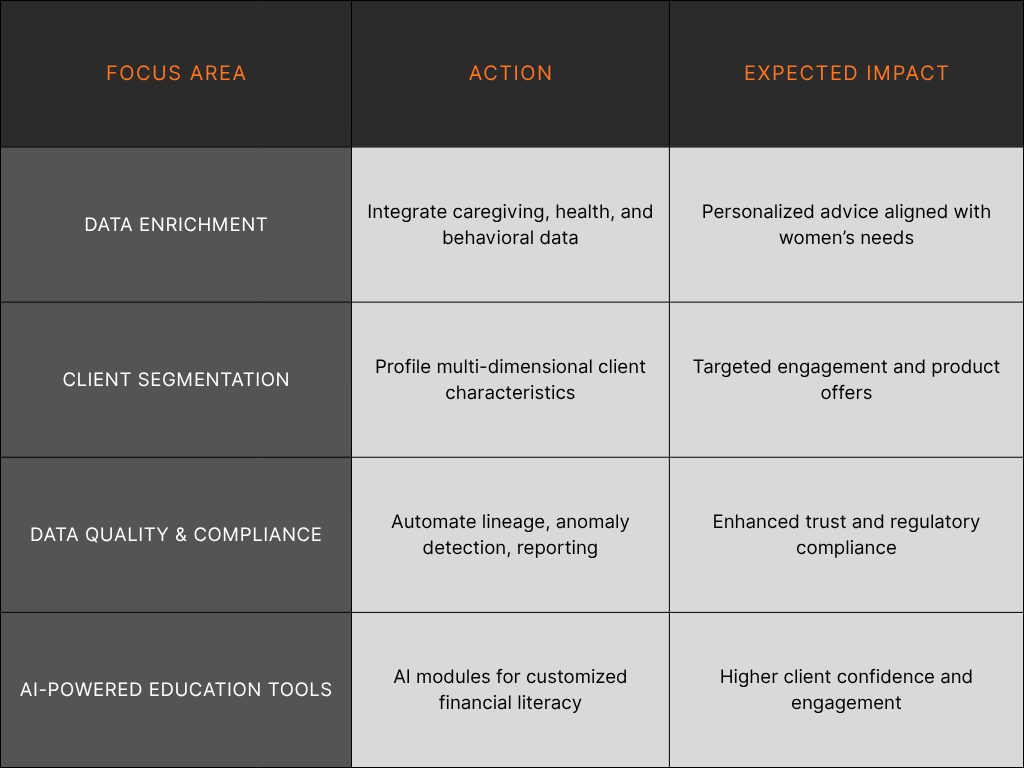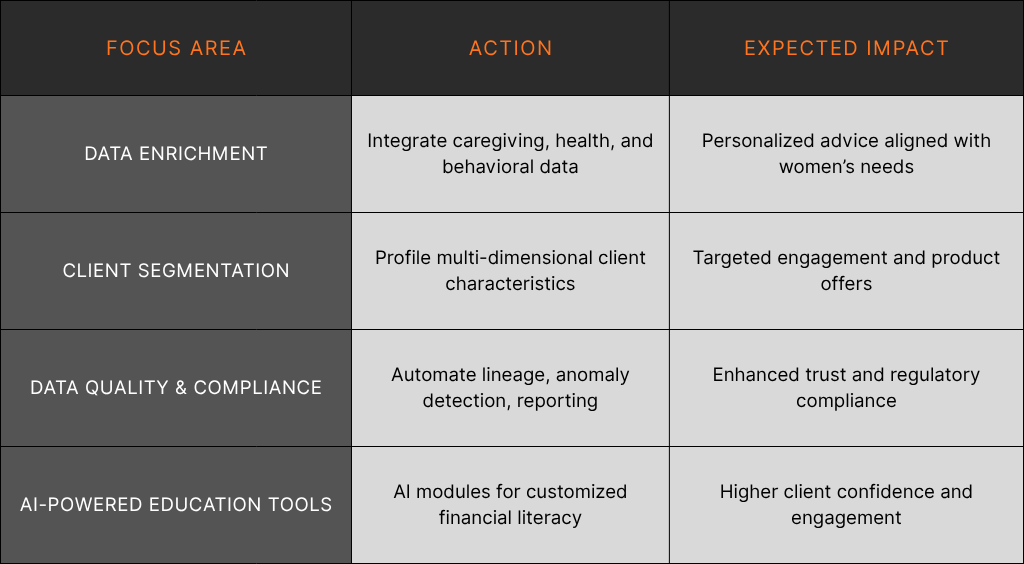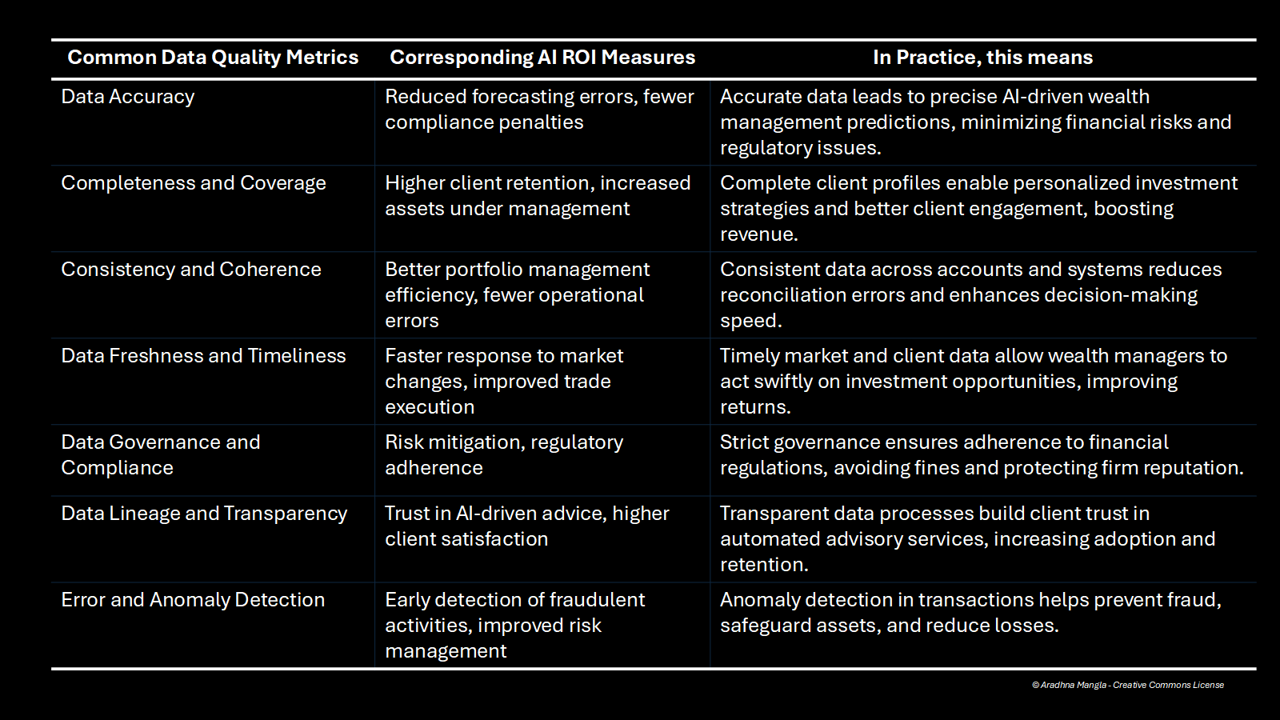A quick primer on Data-Driven Decision-making in Wealth Management
Explore how wealth management firms can unlock true value by advancing through the DIKW pyramid—building from raw data to actionable wisdom. Learn practical steps to improve data quality, analytics, compliance, and decision-making for a future-ready financial practice.
Ever wondered where data challenges start from? What framework should we follow? Where does the cycle start or end? Here’s a quick primer to help frame the problem.
How does this look in Wealth Management Data Organizations?
Here is a high-level flow illustrating key stages from data acquisition to strategic decision-making in wealth management:
Data Collection: Raw data gathering — transactions, client info, market data, regulatory inputs.
Data Integration & Quality Control: Consolidate heterogeneous sources into unified stores; ensure accuracy and compliance.
Information Generation: Produce reports, dashboards, and alerts; contextualize for users.
Analytical Modeling: Apply analytics, risk scoring, and AI-based predictive models.
Knowledge Sharing & Governance: Distribute insights; enforce AI and data governance policies; cross-team collaboration.
Strategic Decision-Making: Make informed, compliant portfolio and operational decisions.
Execution & Monitoring: Implement strategies; continuous compliance and performance monitoring.
Feedback & Improvement: Use outcomes and regulatory updates to refine data, analytics, and governance frameworks.
Now let’s reframe this into a pretty well-known framework out there - the DWIK
Mapping the Data-Information-Knowledge-Wisdom (DIKW) Pyramid onto typical wealth management processes can uncover operational challenges and what organizations can do to climb toward wisdom effectively.
1. Data (Raw, Unprocessed Inputs)
Examples: Transaction records, client demographics, market prices, portfolio holdings, regulatory filings, compliance logs.
Operational Challenges:
Data Overload: Massive, complex data from multiple custodians and systems.
Fragmentation: Multiple data silos and inconsistent formats.
Quality Issues: Missing, inaccurate, or outdated data.
Security & Access: Sensitive financial data access restrictions complicate aggregation.
2. Information (Contextualized and Processed Data)
Examples: Consolidated portfolio views, performance reports, risk metrics, compliance status dashboards.
Operational Challenges:
Integration: Harmonizing different data formats and sources into coherent views.
Timeliness: Delivering up-to-date, relevant information rapidly to advisors and clients.
Visualization: Clear, actionable presentation tailored to stakeholders.
Technology Gaps: Legacy systems slow down information flow.
3. Knowledge (Insights and Understanding)
Examples include identifying client risk profiles, conducting regulatory impact assessments, utilizing AI-driven investment signals, and performing scenario analyses.
Operational Challenges:
Analytical Complexity: Parsing large datasets for meaningful patterns.
Skill Gaps: Need for advanced analytics capabilities and domain expertise.
Governance: Ensuring AI and data analytics comply with regulatory frameworks (FINRA, SEC, NYDFS).
Collaboration: Breaking down organizational silos to share insights.
4. Wisdom (Strategic Decision-Making and Action)
Examples: Tailored client investment strategies that balance risk and compliance; operational improvements that maximize ROI; proactive regulatory risk management.
Operational Challenges:
Decision Alignment: Integrating insights into strategic and compliant actions.
Change Management: Embedding new data-driven practices culturally.
Reputational Risk: Ensuring decisions maintain client trust and regulatory standing.
Measurement: Quantifying compliance ROI and operational alpha.
Hope this helps demystify the inner workings of wealth management data orgs!
Synthetic Data - A Double-Edged Sword
There’s another thread getting pulled in financial services: while data powers innovation, regulations and trust keep us cautious. When wealth and asset managers apply AI solutions, they do it knowing client confidence is the anchor. Synthetic data steps in where real data can’t safely go—it opens doors for model development, speeds experimentation, and fortifies privacy. In my view, this is the future path for responsible AI - but only if it is done right.
“Life in plastic, it’s fantastic”
Synthetics are everywhere - in our clothes, our food, and now in our data too. But it’s not all bad. Imagine Spandex: elastic, resilient, and transformative, enabling comfort and movement in sportswear and business apparel.
Synthetic data too carries a similar promise for AI - helping us stretch boundaries and simulate outcomes, adapt to unobserved events. Like blended fabrics, the aim is to enhance function and innovation, but the wrong mix can have it’s unintended effects.
So what is Synthetic Data in Financial Services?
Simply put - Synthetic data is generated by computers to resemble real-world data in pattern and structure.
Here’s an example side by side
See the problem? The synthetic data could be a real row from a customer table, or completely made up.
The example above is a simple one. Real-world synthetic data is richer, with Personally-Identifiable Information such as SSNs, Digital Identifiers like IP addresses, and so on.
Models need customer histories and transaction details, so to counter data sharing risks, AI teams can create data “twins” for customer records. These are generated by machines to echo real-world patterns.
Now comes the risk management perspective:
How can we reduce bias and protect privacy without sacrificing innovation? Rigorous validation ensures synthetic datasets truly represent real-world patterns, catching anomalies before AI models learn from flawed data. I’ve found 3 methods to work well with AI and Data Teams.
1. Statistical Similarity Checks
Banks generate synthetic transaction data that maintains key statistical properties of real customer data. For example, if the original dataset shows that most customers spend under $100 per transaction and have occasional peaks on weekends, the synthetic set should reflect these patterns. Financial institutions compare metrics like average transaction amount, frequency, and correlation between spending categories to ensure synthetic data realistically mimics customer behavior. This helps AI models trained on synthetic data behave accurately once deployed.
2. Model Utility Testing (Train-on-Synthetic, Test-on-Real)
Fraud detection models benefit greatly from synthetic data because genuine fraud cases in training data are rare. By creating synthetic fraudulent transactions mirroring real fraud patterns, such as unusual merchant locations or transaction timings, banks can train more balanced models. These models are then tested on real transaction data to confirm their ability to detect genuine fraud.
3. Privacy Risk Assessment
Synthetic data must not expose any actual customer details. Privacy assessments evaluate re-identification risks using methods like membership inference attacks or similarity searches. In personalized finance, synthetic datasets are scrutinized to confirm zero chance of tracing transactions back to an individual’s account. By deploying privacy-preserving synthetic data generation platforms, banks can safely share insights across teams or with partners without violating strict financial privacy regulations.
Together, these validations ensure synthetic data is both ethically safe and practically useful, enabling advances in personalized finance such as tailored credit scoring, fraud analytics, and customer behavior modeling without compromising privacy or accuracy.
Bottom-line:
Data leaders who implement these three validation methods can accelerate AI innovation while meeting increasingly strict privacy regulations. This approach transforms compliance from a barrier into a competitive advantage, enabling secure data sharing across teams and with partners without regulatory exposure.
The result: faster time-to-market for AI-driven financial products with built-in trust and transparency.
Further Reading:
https://en.wikipedia.org/wiki/Synthetic_data
https://www.snowflake.com/en/fundamentals/synthetic-data/
Preparing for the demographic shifts in generational wealth transfer
wealth management, financial advisory, data strategy, AI governance, wealth transfer, women inheriting wealth, personalized financial planning, regulatory compliance, asset management consulting, Snowflake data platform, responsible AI, financial data quality
A very interesting insight caught my eye the other day. We know that there is an estimated USD 124 trillion in assets set to be transferred from older generations to younger ones in the U.S. by 2048.
But if you dive into the data, one demographic stands out - women.
Power is shifting within households and purchasing power patterns are ever-changing in the economy. Women are increasingly inheriting and controlling wealth. Public data from the Certified Financial Planner (CFP) Board's 2025 report, Building Wealth: Insights on Women’s Aspirations & Growing Financial Power, reveals that women’s economic influence is surging, reshaping wealth management imperatives. By 2023, women’s economic power was projected to reach $34 trillion. Wealth transfer to younger generations positions them as primary decision-makers and asset holders. As this wealth transfer accelerates, estimated at $84 trillion (a lioness share of the pie!) across generations through 2045, wealth management firms and their data teams must proactively adjust strategies to meet the financial priorities and behavioral characteristics unique to women clients.
Understanding this Wealth Shift with data
Women’s labor force participation climbed from 43.0% in 1969 to 57.3% in late 2024, rising while men’s participation declined. Educational attainment among women has surpassed men, with 47% of women aged 25 to 34 holding bachelor’s degrees compared to 37% of men. These educational gains are critical since higher education correlates strongly with lifetime earnings and wealth. For example, a 2021 Georgetown University report found that women with bachelor’s degrees earn a median of $2.4 million over their lifetime compared to $1.3 million for women with only a high school diploma.
These trends have culminated in women controlling a growing share of U.S. wealth. Estimates suggest women held one-third of financial assets in 2019. The Bank of America Institute, a public think tank, forecasts that approximately $30 trillion will transfer specifically to younger women, dramatically elevating their financial influence in the years ahead.
So what are our priorities?
Women’s financial priorities often extend beyond traditional wealth accumulation to include caregiving responsibilities, emergency savings, and retirement security. The CFP Board report highlights that more than two-thirds of women surveyed serve as primary investment decision-makers within their households. Women tend to prioritize:
Comfortable retirement savings and not outliving their money (83%) - Check
Increasing retirement savings (71%) - Check
Maintaining sufficient emergency funds (68%) - CHECK!
Managing healthcare and long-term care costs (45%) - Check (Someone’s gotta budget for that Oura Ring subscription!)
While women display confidence in managing day-to-day finances such as budgeting, bill-paying, and debt management, they also seek professional guidance with investing, estate planning, and wealth building.
Financial planners are highly needed, with 56% of women stating that they rely on financial planners to achieve their financial goals. A hands-on approach works better, despite increasing levels of fintech automation.
What are the implications for Wealth Management Data Teams/ Data Offices
Key considerations include:
Client Data Enrichment with Behavioral Insights: Incorporate data sets and analytics that reflect women’s unique financial behaviors - caregiving costs (Care.com?), health-related expenses, tax considerations, and philanthropic interests - to enable personalized advisory services.
Enhanced Segmentation and Personalization: Develop advanced segmentation schemas in platforms like Snowflake and Data Catalogs that distinguish clients not only by assets but also by caregiving roles, risk tolerance linked to retirement concerns, and financial knowledge confidence levels.
Robust Data Quality and Compliance Controls: People increasingly relying on transparent, trusted advice meaning post-trade - there is a need to defend data accuracy and lineage for regulatory compliance (SEC, FINRA) and client trust. Embedding AI-driven quality checks and compliance automation can streamline oversight and reporting.
AI-Assisted Education and Engagement Tools: Deploy AI-driven insights and customizable content modules supporting women’s aspirations for education on investing and wealth building to cultivate confidence and deepen engagement.
Privacy and Ethical AI Governance: Given the sensitive nature of caregiving and personal finance data, wealth firms must rigorously apply AI governance frameworks aligning with principles from NIST, IEEE, and OECD to ensure fairness, transparency, and compliance. An ethical complication can arise if credit decisions are skewed due to an individual caregiving demands.
Let’s takeaway a practical checklist for Data Teams
Non-exhaustive list
So….what are some takeaways?
Analytics, Business, and Data teams should discuss, at minimum:
How well do our client data frameworks capture the nuanced financial realities of women clients, including caregiving and health concerns?
Are our AI tools and compliance frameworks aligned with the latest ethical standards to avoid unintended biases?
How can we innovate our financial education offerings to meet women’s expressed desire for knowledge and empowerment?
What would an implementation case study look like?
Let’s look at AI Governance and Data Strategy in Action at a Large Wealth Manager
Context: A leading wealth management firm serving high-net-worth clients recently embarked on a transformation project integrating Snowflake for cloud data warehousing and a name-brand data catalog for data governance. They deployed GitHub Actions to automate data quality checks and compliance workflows. The adoption of AI-powered predictive analytics enabled hyper-personalized investment recommendations, aligned with client risk profiles.
To meet SEC and FINRA scrutiny, the firm implemented an AI governance framework based on NIST guidelines, ensuring transparency and auditability in AI outputs. Rigorous third-party reviews of AI vendor platforms mitigated data privacy and operational risks. This integrated approach reduced compliance incidents by 30%, improved client satisfaction scores, and drove a 15% revenue uplift via new client acquisition and retention over 18 months.
Of course, implementation realities are different. But this is a decent baseline for firm strategy.
Preparing now ensures wealth management firms are not only compliant and operationally effective but also best positioned to support the next generation of financially empowered women.
Further reading/Materials Referenced are publicly available resources.
Fortune, 2025. The $124 trillion Great Wealth Transfer is bigger than ever [Online]. Available at: https://fortune.com/2025/07/23/great-wealth-transfer-124-trillion-bigger-than-ever-millennials-gen-x/ [Accessed 11 October 2025].
Cerulli Associates, 2024. Cerulli anticipates $124 trillion in wealth will transfer through 2048.
CNBC, 2025. Most of $124 trillion 'great wealth transfer' will go to women [Online]. Available at: https://www.cnbc.com/2025/03/12/most-of-the-124-trillion-great-wealth-transfer-will-go-to-women.html [Accessed 11 October 2025].
Certified Financial Planner Board, 2025. Building Wealth: Insights on Women’s Aspirations & Growing Financial Power [Online]. Available at: https://www.cfp.net/-/media/files/cfp-board/knowledge/reports-and-research/womens-initiative/building-wealth-insights-on-womens-aspirations-growing-financial-power.pdf [Accessed 11 October 2025].
Bank of America Institute, 2024. Women and Wealth 2024.
Bank of America Institute, 2024. Investing in Women insights [Online]. Available at: https://business.bofa.com/en-us/content/investing-in-women [Accessed 11 October 2025].
Pew Research Center, 2024. Rising educational attainment among young women has had positive economic effects [Online]. Available at: https://www.pewresearch.org/fact-tank/2024/04/23/rising-educational-attainment-among-young-women-has-had-positive-economic-effects/ [Accessed 11 October 2025].
Georgetown University Center on Education and the Workforce, 2021. The College Payoff [Online]. Available at: https://cew.georgetown.edu/cew-reports/the-college-payoff/ [Accessed 11 October 2025].
You can’t outrun a data mess
Discover why strong, high-quality data foundations are essential for successful AI initiatives. Learn how bad data quality slows AI progress, the role of data governance, and the deep connection between trusted data and AI ROI. Empower your AI projects by investing in resilient data quality practices and governance frameworks to avoid costly bottlenecks and trust erosion.
Anyone who’s worked on AI initiatives knows this truth: slow progress on data quality keeps most Data Leaders awake at night. These leaders live and breathe data governance and quality—they’ve seen the consequences of bad data firsthand and are eager to fix it. Engaging with these champions early in an AI journey is almost a rite of passage; they become your essential allies in building robust foundations that AI truly needs.
But why does fixing messy data matter?
The nagging feeling that people on both sides of the table continue to have, as we scale AI adoption across the Enterprise is = the correlation between data quality metrics and AI ROI is fundamental and deep. High-quality data is the bedrock upon which AI's potential for delivering measurable business value rests. And achieving high-quality, trusted data is still a distant goal for many enterprises.
Let’s take a simple, 10,000 ft view of our commonly measured Data Quality metrics, and their impact on AI use cases.
Simple is key to democratizing the idea, and engaging stakeholders IMO
So what does bad data quality mean when we ‘apply AI’?
Before we proceed further, we must establish some facts: we cannot ‘govern’ 100% of enterprise data - there simply isn’t an ROI. However, in today’s risk environment, we should at least be able to know where the organizations’ data is, where it comes from, and if it is authorized for use.
So yes, there will always be some ungoverned, messy data lying around. Just hope it’s not the stuff going into your credit decision model!
Since there isn’t a perfect/one way to measure the aggregate impact of data quality - here’s an idea open to discussion:
Why don’t we do some napkin math and observe the interaction between AI models, your internal and external data sources, columns of data to maintain, and impacts on the Data Steward - who is still 100% human, and working with a variety of Data Management Tools, Emails, Meetings, and Excel Templates?
“(Number of AI Models) × (Data Sources per Model) × (Data Points per Source) × (Data Quality Remediations per Data Point) = Total Data Quality Tasks”
What does this mean in reality?
There are about 2 million models out there in the world. They range from public to private, branded, big names to unsecure, shadily out there.
If we take a ballpark range of model usage by use case/enterprise size (this might serve as a good class table)
Large enterprise: 500–2,000 models
Medium enterprise: 100–500 models
Small enterprise: under 100 models
Where does this leave us - in a conservative scenario of a .02% error rate?
“1,000 AI models × 10 data sources per model × 100,000 data points per source × 0.0002 error rate = 2,000,000 data quality incidents to monitor and remediate”
Even if only 0.02% of your data has issues, that’s potentially hundreds of thousands of incidents daily. Can your teams triage, fix, and optimize fast enough? Without solid data quality foundations, AI projects risk becoming bottlenecks, eroding trust, and wasting investment dollars.
Attempting to “outrun” a data mess is a myth - experienced Data Leaders know that strong, resilient data foundations must precede any ambitious AI project. Investing in data governance, rigorous validation, timely updates, and unified data standards is critical for preparing “AI-ready” data sets that enable successful business outcomes.
Leading the AI and Data Product Transformation in Financial Services
We all hear it everyday, and may I say every waking moment nowadays? Artificial intelligence continues to present extraordinary opportunities for financial services firms to innovate, optimize operations, and deepen client relationships. Yet, after years of ambitious AI efforts, many organizations still struggle to scale impactful use cases at speed. My assertion is that the root cause often lies in how data is managed across the enterprise.
From my experience advising leading financial firms, the most profound shift enabling AI at scale is their transition to a federated data product model. I can count the leaders who are taking a ‘prioritize and clean data domains’ approach instead of fragmented, project-driven data efforts or overly centralized data lakes struggling to meet business-specific needs. The takeaway is - data must be treated as a product that serves clearly defined domains, use cases, and needs of the enterprise.
The most significant shift I’ve seen driving AI maturity is the move to a federated data productmodel. Leading firms are prioritizing critical data domains—rather than scattered projects or centralized data lakes that often fail to meet dynamic business needs—with an explicit focus on treating data as a product.
But what does this mean in practical terms for wealth managers?
Domain ownership and accountability: Cross-functional teams comprised of portfolio managers, client service professionals, data scientists, and technologists own the end-to-end lifecycle of curated datasets. For example, a “Client Profile” data product enables advisors to access clean, enriched client risk profiles, preferences, and holdings—all essential for personalized portfolio recommendations powered by AI.
Data as a living product: These data products are continuously refined and versioned based on changing regulatory requirements or evolving client expectations. A fixed data extract is replaced by dynamic, enriched datasets—for instance, ESG scoring data continuously updated and embedded into client dashboards to support sustainable investing mandates.
Federated governance with platform enablement: Central platform teams provide the backbone—cloud infrastructure, data engineering tools, and compliance guardrails—while domain teams accelerate value delivery without sacrificing controls. For instance, secure access to transactional data enables real-time fraud detection using AI models embedded into operational workflows.
But how do Data Products accelerate AI adoption?
Faster delivery of trusted, domain-specific data: AI models can be trained and deployed rapidly on datasets like aggregated risk exposure across multi-asset portfolios, enabling near real-time analytics and personalized client insights.
Risk mitigation through embedded quality and compliance: Pre-built validations in products like trade blotter data reduce errors and ease compliance with regulatory reporting (e.g., SEC Form PF submissions).
Enhanced collaboration: Bridging gaps between quants, technologists, and relationship managers improves model accuracy and adoption, for example, in AI-enabled client sentiment analysis.
Agility to respond to evolving needs: Dedicated teams can independently evolve products like “Market Intelligence Data” to support new AI-driven product allocation or proposal automation initiatives.
Well, what are actionable steps for wealth management leaders:
Map your enterprise data landscape to identify silos and prioritize high-impact domains such as Client Insight, Investment Research, and Regulatory Data.
Launch a federated data product initiative with clear roles, business outcomes, and KPIs tied to AI use cases—such as improving onboarding experience with AI-powered suitability assessments.
Invest in robust platforms and catalogs that empower fast, governed access to curated datasets used by portfolio managers, compliance officers, and AI models alike.
Form agile, multidisciplinary teams owning data products aligned to evolving wealth management goals—model risk, compliance, digital client engagement.
Use rigorous metrics around data freshness, quality scores, and end-user satisfaction to continually optimize data products and AI success.
In my view, wealth managers who embrace this federated data product model are uniquely positioned to unlock AI’s exponential value—delivering personalized, regulatory-compliant solutions with agility and integrity.







